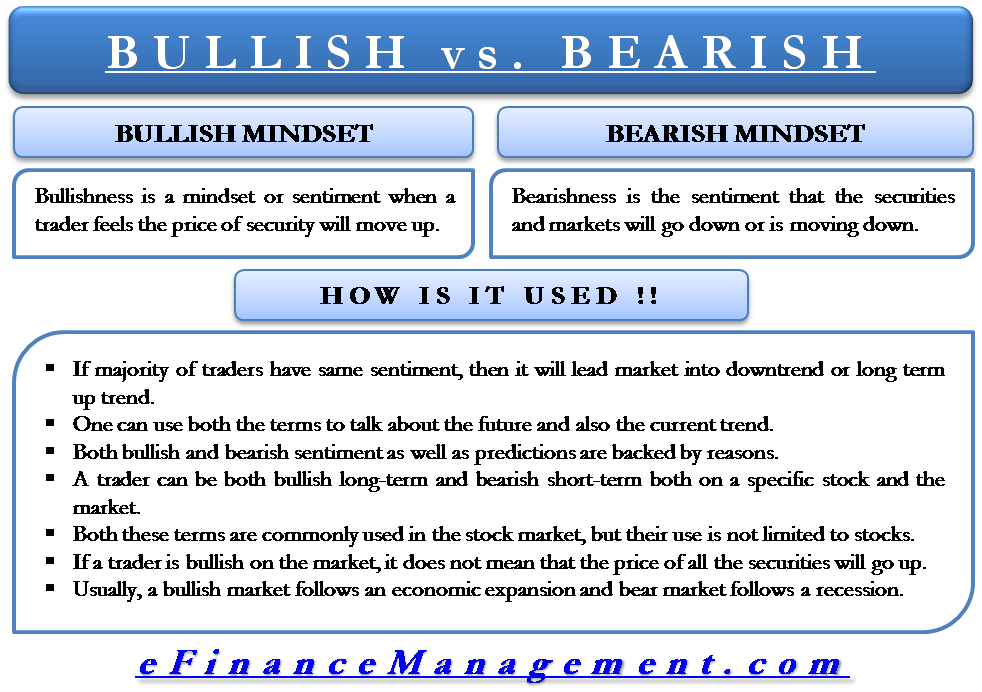The term bullish and bearish describes the condition in the market or the sentiment of the investors, or a general market trend. Both bullish and bearish are the antonym of each other. If a market is in a long-term uptrend, it is called a bull market, and if the market is in a long-term downtrend or the prices are falling continuously, it is called a bear market.
For instance, you must have heard a trader or analyst say that “I am bullish on Company A.” This means that the trader or analyst expects the stock price of the said company to go up.
A Bullish Mindset
Bullishness is a mindset or sentiment when a trader feels the price of a security will move up. Usually, if a market recovers 20% or more from the bottom, it is in a bullish phase. As the name suggests, the term ‘bull’ is inspired by the bull, who hits upwards with the horns. And that is why it represents prices going up.
A Bearish Mindset
Bearishness is the sentiment that the securities and markets will go down or is moving down. As the name suggests, the term ‘bear’ or ‘bearish’ comes from a bear, which hits downward with its pawns. Bears usually represent sellers in the market. They resort to selling as they believe things will get worse. Similar to the bull phase, a market or security enters the bear phase if it drops more than 20%.
Bullish and Bearish – How They are Used?
- A point to note is that the term bullish and bearish describes both the sentiment and trend toward a specific stock and also the whole market. For example, if a trader says that he is bearish on the stock market, it means he expects the market to drop. A trader may have their own bullish and bearish sentiment. But, if most traders have the same sentiment, it will lead a market into a downtrend or long-term up.
- One can use both the terms to talk about the future and the current trend. For example, one can say that the market is in a bullish phase, meaning the market is dropping. On the other hand, if one says that the market will have a bull run in summer, it will mean future expectations.
- Also, both bullish and bearish sentiment and predictions are backed by reasons. For instance, if a trader says that he is bullish on Apple after Q3 earnings, it means that the company will announce upbeat Q3 earnings, which will push the stock prices up.
- A trader can be both bullish long-term and bearish short-term both on a specific stock and the market. For example, new tax reform may push the market down initially, but it could push the market up in the long term.
- Both these terms are commonly used in the stock market, but their use is not limited to stocks. One can use them to represent the trend in any financial market, including real estate, commodities, and more.
- If a trader is bullish on the market, it does not mean that the price of all the securities will go up. Similar is the case with the bear phase as well.
- Usually, a bullish market follows an economic expansion, and a bear market follows a recession. However, it is not always the case. A market can have a bull run without economic expansion or a bull market without a recession. Sometimes, a bull market follows a bear market, and vice versa.

How They can Help Traders?
Knowledge of bullish and bearish market conditions could help traders make profits easily. Sufficient knowledge of these terms helps traders identify bull and bear cycles beforehand, thus, taking positions accordingly.
Traders can make profits in both bearish and bullish cycles. If a trader expects a bull, he can buy the security or hold onto it for more time. And, if a trader expects the prices to drop, then he can sell the securities now to avoid losses. They can also short the stock if they expect the price to drop.
Conclusion
Every trader must know and understand both these terms clearly as they are frequently used in the financial markets. Also, these terms help you understand the market more clearly and make profits irrespective of whether you are a day trader or a long-term investor.
RELATED POSTS
- Sentiment Analysis – Meaning, Explanation, and Indicators
- Contrarian Strategy – Meaning, Execution, Advantages, and Disadvantages
- Trend Analysis – What It Means, Uses, Types And More
- Market Momentum – Meaning, Indicators, and Use
- Recession vs Depression – All You Need to Know
- Recession – Meaning, Causes, Indicators and More

